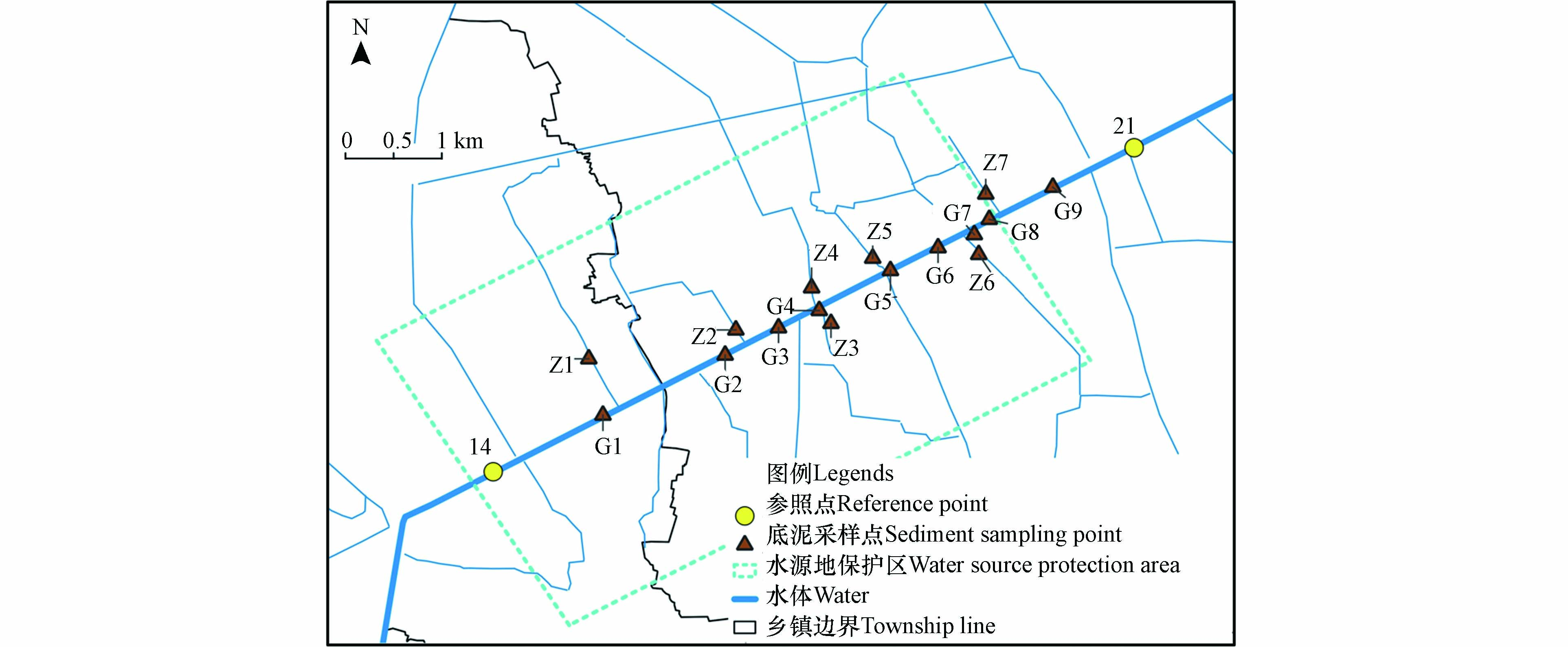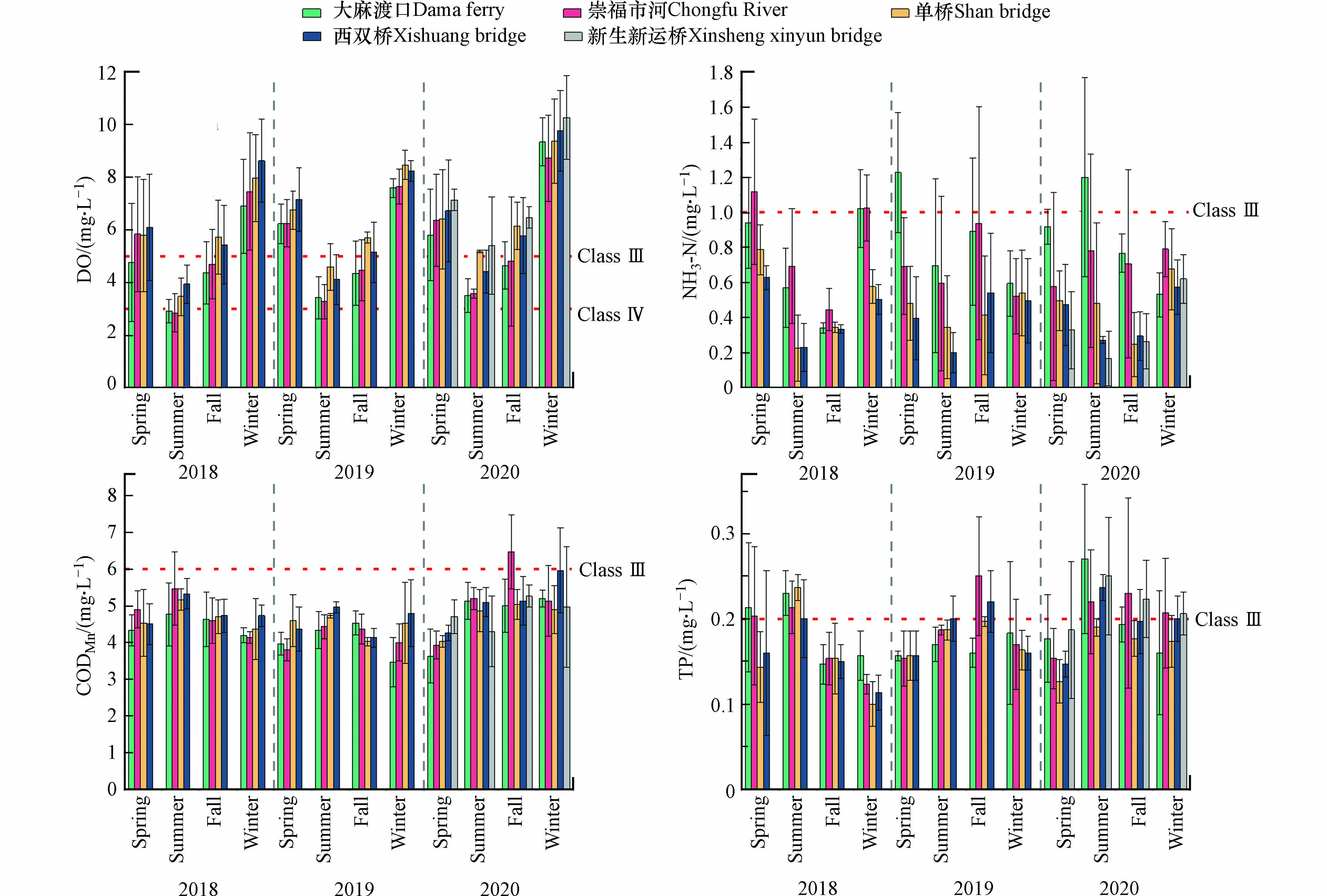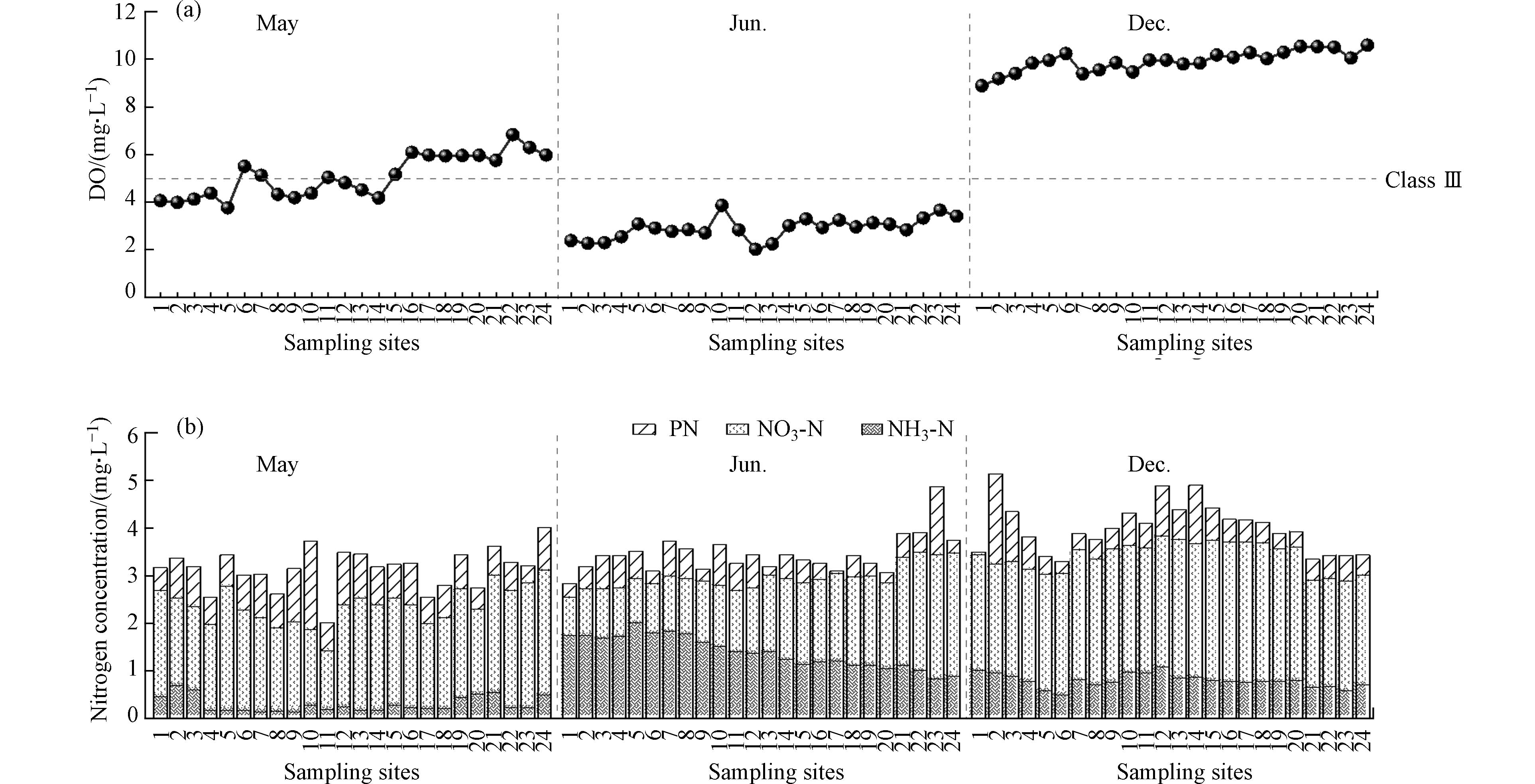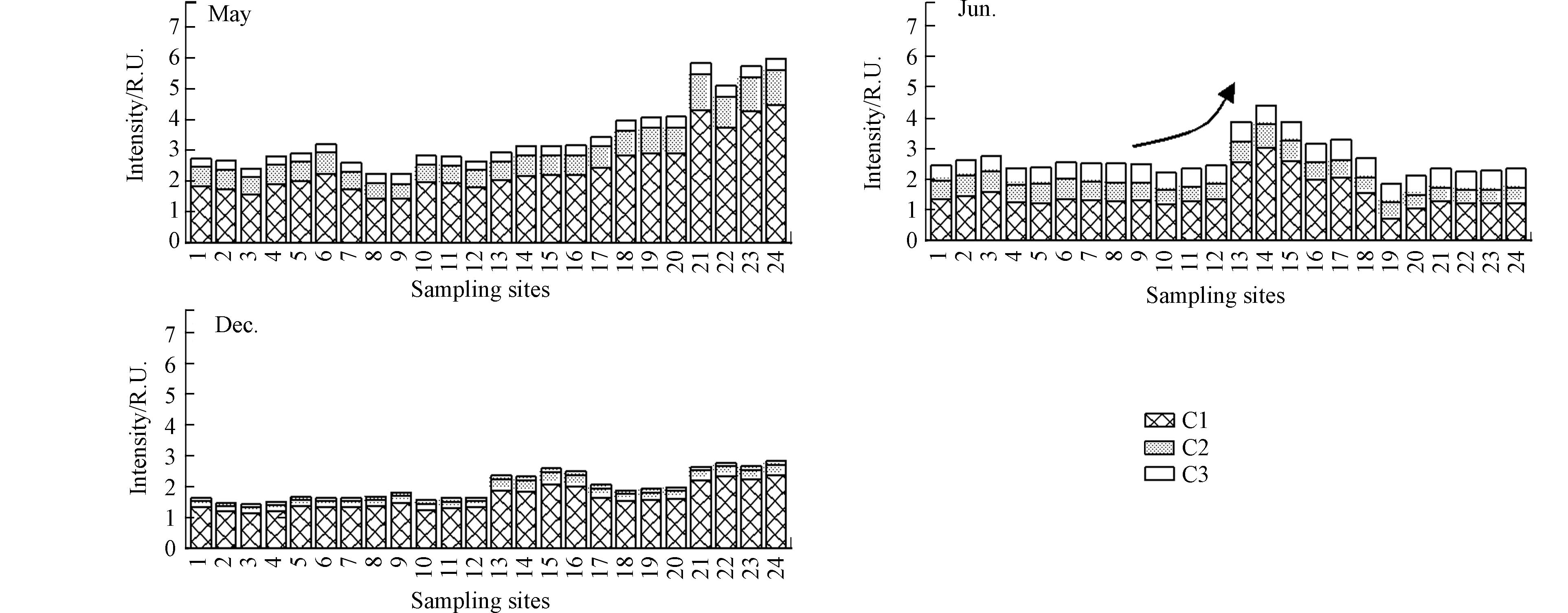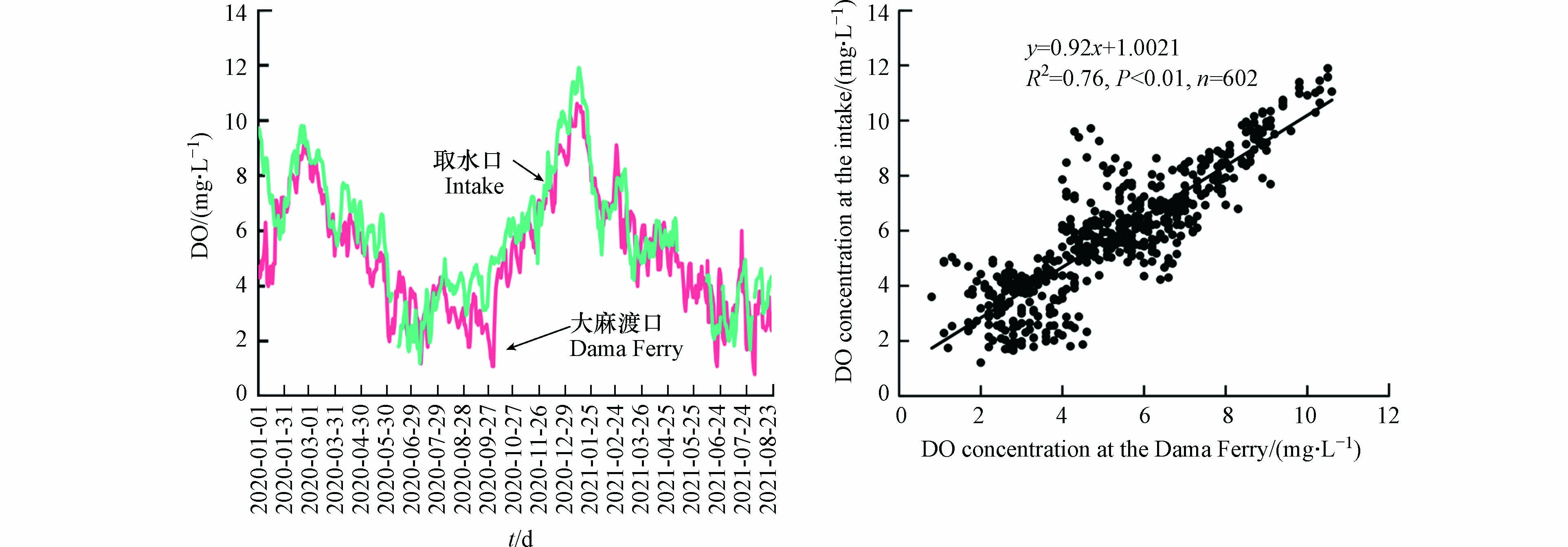-
运河桐乡水源地处长江三角洲平原河网地区,承载桐乡市3个自来水厂的供水工程,是桐乡市集中饮用水源,每天向3个水厂供水45万吨,其水质好坏直接关系到桐乡市70多万人的饮用水安全. 随着长三角社会经济的快速发展和城市化进程加快,运河水体负荷不断增加[1],加上平原河网地势平坦,水动力条件较差,水环境自净能力差[2-3],运河桐乡水源地近年来夏季溶解氧(dissolved oxygen, DO)时有超标. DO是评价水体自净能力和受污染程度的重要指标[4-5]. 当水体中DO ≤ 2 mg·L−1时,厌氧微生物在水体中占主导地位[6],有机物分解过程会产生对人体有毒有害的物质和刺激性气体[7-8],从而影响河网生态环境和饮用水安全[9].
平原河网地区造成水体DO低下的原因往往比较复杂. 影响水体DO浓度的因素很多,包括pH、温度、电导率、营养物质浓度、大气复氧水平和水动力过程等[10-12]. 国内外学者尝试使用了多种方法对水体中DO低下的原因进行研究. 例如,Lopamudra[13]建立Streeter-phelps模型,发现下游水体低DO可能是由于上游水体点源污染增加或溶解态氮浓度较高而导致藻类过度生长所致. Espinosa-Díaz等[14]对圣玛尔塔湾连续19年的DO数据进行时间序列分析,发现水体DO浓度下降与沉积物中有机物的消耗有关. Jarvis等[15]对墨西哥湾北部水体建立三维水动力-生物地球化学模型,发现风力驱动因素会促进近海水域DO的消耗. 赵海超等[16]通过氮磷形态及相关性分析发现水体富营养化和底泥释放氮磷营养盐导致了洱海DO浓度降低. 黄钰铃[17]等通过水体分层研究发现,泸沽湖北侧湖区DO低是由于湖区水动力特性、以及水生植物和浮游植物群落的差异所致. 由此可见,不同水体低DO成因不尽相同,必须依托一定的技术手段深入解析水体低DO成因,才能更有针对性地提出治理对策.
三维荧光光谱(Three-dimensional fluorescence excitation-emission matrix spectroscopy,3DEEMs)作为一种新型水污染溯源技术,具有快速、准确的优点[18]. 将3DEEMs和平行因子分析(Parallel factor analysis,PARAFAC)结合使用能有效揭示水体中溶解性有机物(Dissolved organic matter,DOM)的荧光组分信息,被广泛用于探究不同水体DOM组成及来源[19-20]. 这种方法不受水体类型限制,应用于对不同污染源的识别分析,但还未见利用这种方法对水体低DO进行成因分析的相关报道.
本文基于常规水质监测数据,研究了运河桐乡段水体的DO时空分布特征及其主要影响因素;基于三维荧光光谱结合平行因子分析法和氮形态解析,探究了桐乡入境水和桐乡内部污染源对水源地DO的影响;通过底泥分析结合现场踏勘,分析了底泥污染物释放对水源地DO的影响. 研究结果不仅可以为长三角平原河网地区“精准治污”提供新思路,也能为其他地区低氧水体的治理提供参考.
-
运河桐乡段位于长三角平原河网地区的核心地带,上承杭州临平来水,贯穿嘉兴桐乡40.11 km,途径大麻渡口、崇福市河、单桥、西双桥、新生新运桥五个控制断面,最终流入嘉兴市秀洲区. 受地理条件限制,运河桐乡水源地的取水口距离运河III级航道不到1 km(图1).
-
运河桐乡段主要控制断面历年水质季节变化分析. 取浙江省嘉兴生态环境监测中心2018年3月—2021年2月每月1次的手工监测数据,将各月监测数据按3—5月、6—8月、9—11月、12—翌年2月分别取平均,得到春、夏、秋、冬四季浓度.
大麻渡口断面和运河桐乡水源地取水口的DO日均数据. 取大麻渡口和运河桐乡水源地取水口自动监测站2020年1月1日至2021年8月23日的日均在线监测数据,用于分析水源地DO对上游来水DO的依存度.
文中其它数据,来自对运河桐乡段水质的加密采测.
-
2020年5月、6月、12月对运河桐乡段进行加密采样监测. 在干流上设置24个水质采样点,各采样点间隔800—1000 m,采样点分布见图1. 其中,监测点1、8、18、21、24分别对应控制断面大麻渡口、崇福市河、单桥、西双桥、新生新运桥,监测点14—19为水源地保护区段,水源地取水口对应点19.
大麻渡口是省控断面,用于监测上游来水;崇福市河、单桥是市控断面,分别用于监测崇福镇和运河桐乡水源地水质;西双桥是省控断面,用于监测运河桐乡水源地下游水质;新生新运桥是“十四五”新增国控断面,用于监测运河桐乡出境水质. 每个采样点分别采集表层0.5 m处水样,DO浓度使用便携式溶解氧仪(METTLER TOLEDO,Germany,Seven2GO Pro S9)现场测定. 水样低温保存在采样瓶中立即送往实验室,在规定时间内完成各项指标的测定.
2020年6月在水源地保护区内设置16个底泥采样点,G1—G9为干流底泥监测点位,Z1—Z7为支流底泥监测点位(图2). 底泥采样根据《沉积物质量调查评估手册》[21],用抓泥斗抓取表层0—20 cm底泥样品,现场记录底泥的颜色、气味、形状等物理性质,挑出杂质. 放置于密封袋中并排出多余空气,立即送往实验室,尽快完成各项指标测定.
-
水质测定项目包括总氮(TN)、溶解性总氮(DTN),颗粒态总氮(PN)、氨氮(NH3-N)、硝酸盐氮(NO3-N). 其中,总氮测定使用原水样,溶解性总氮测定使用经0.45 μm水系滤膜[22]过滤后的水样. 颗粒态总氮由总氮与溶解性总氮差减获得. 氨氮、硝酸盐氮、总氮测定分别依据《水和废水监测分析方法(第四版)(增补版)》中纳氏试剂分光光度法、酚二磺酸光度法和碱性过硫酸钾紫外分光光度法[23]. 监测站逐月监测数据显示运河桐乡段水体中亚硝酸盐氮含量极低,部分月份未检出亚硝酸盐氮. 6月(夏季)水体DO浓度低,采样后使用国标法测定了亚硝酸盐氮的含量,测试结果表明其浓度占氮浓度的比例很低,仅为2.6%—4.2%. 亚硝酸盐为硝化反应的中间产物,且在自然环境中容易发生氧化和还原反应,因此未将亚硝酸盐氮列为测试指标.
底泥测定项目包括总氮(TN)和总磷(TP),测定前将冷冻干燥后的泥样研磨过100目筛,保存备用. 底泥总氮测定参照文献[24];总磷测定依据高氯酸-硫酸消解法[21].
为保证测试结果准确性,实验过程中采用质控样并抽取10%平行样测试.
-
水质的三维荧光光谱使用日立荧光分光光度计F-4700依据文献[25]测定. 测试前将水样用孔径0.22 μm的Millipore滤膜过滤. 主要参数为:激发波长(Ex)220—450 nm,扫描间隔5 nm,狭缝宽5 nm;发射波长(Em)260—450 nm,扫描间隔1nm,狭缝宽5 nm;光电倍增管电压为700 V;扫描速度为2400 nm·min−1,以Milli-Q超纯水为试验空白.
平行因子分析用于识别和分离3DEEMs中受到干扰及重叠的荧光峰,并表征DOM各荧光组分特征[23]. 原理是基于三线性分解理论,采用交替最小二乘原理的迭代类型三维数阵分解算法,将三维荧光光谱的原始数据拆分为不同特征峰进行解谱,对不同荧光组分进行定性和定量分析[26-28]. 所有数据均按照每天使用超纯水的拉曼散射峰对水样的荧光值进行拉曼单位转换,荧光强度大小以单位R.U.(Roman Unit)标注. 平行因子分析的详细参数条件参照文献[29].
-
水源地取水口和大麻渡口断面安装有水质自动监测站,由于自动监测数据较为充足,因此采用一元线性回归分析法探究水源地取水口和大麻渡口日均DO浓度之间的相互依存度. 采用回归系数R2判别回归模型的拟合度,其中P <0.01分别表示变化趋势极显著.
水源地取水口和大麻渡口以外的控制断面没有安装水质自动监测站,DO数据只能通过每月一次的手工监测获得,因数据量较小无法准确建立回归模型,故采用相关分析法[30]分析大麻渡口与其他各控制断面之间DO浓度的关系,当相关性系数r >0.8时,认为变量间呈极强相关关系[31].
一元线性回归分析和相关性分析利用SPSS 22.0进行,平行因子分析采用MATLAB R2021a进行.
-
控制断面2018—2020年水质变化情况如图3所示. 大麻渡口断面总体为III类水,但夏季常为IV类,2018年夏季甚至一度达到V类,主要超标因子为DO,其次为总磷. 运河桐乡水源地单桥断面总体为III类水,夏季常为IV类,主要超标因子为DO,其余季节能稳定达到III类. 新生新运桥国控断面总体为IV类,主要超标因子为总磷. 夏季水源地和各市控及以上断面DO不能稳定达标.
从上下游变化来看,DO浓度在各年度、各季度都呈现从上游到下游的逐渐升高趋势,升高幅度为0.65—1.91 mg·L−1. 氨氮浓度在崇福市河断面附近有时明显升高,随后沿运河整体表现出明显下降趋势,出境比入境降低幅度为 -0.09—1.03 mg·L−1. 高锰酸盐指数在各断面基本能保持在III类以下,个别断面的个别时段浓度上升幅度较大,但未观察出明显的时空变化规律. 总磷浓度夏秋相对较高,春冬季相对降低,大麻渡口断面最高0.27 mg·L−1达到IV类,此后在各断面有较大升幅或降幅,2018年出境略低于入境,但2019年后出境浓度比入境升高,2020年四个季节的上升幅度为-0.02—0.05 mg·L−1. 从年度变化来看,与2018年水质相比,运河桐乡段2020年的DO略有改善,但氨氮、总磷和高锰酸盐指数均有所升高.
-
控制断面之间距离较长,难以用于详细探究桐乡各行政区域自身发展对运河水质的影响. 因此,2020年在运河桐乡干流布设24个采样点,分别于5月(平水期)、6月(丰水期)和12月(枯水期),对DO和不同形态氮浓度进行加密监测.
运河干流各监测点DO浓度的沿程变化如图4(a)所示. 与平水期和枯水期相比,丰水期DO 浓度整体偏低,约为2.02—3.86 mg·L−1. 监测点1浓度较低,约为2.38 mg·L−1,点1—10之间浓度缓慢上升,点11—13附近出现明显下降,点13之后进入水源地保护区,DO浓度又呈现小幅升高.
运河干流各监测点氮形态沿程变化如图4(b)所示. 丰水期和枯水期TN浓度略高于平水期,且以溶解态为主. 值得注意的是,丰水期氨氮占比明显高于其它时期,例如采样点1—8,氨氮浓度在丰水期为1.69—2.01 mg·L−1,而平水期和枯水期浓度分别只有0.14—0.69 mg·L−1、0.50—1.01 mg·L−1. 另外,平水期和枯水期氨氮与硝氮变化趋势不明显,但丰水期氨氮在运河沿程明显下降,硝氮明显上升.
-
图5为研究区域来水断面大麻渡口丰水期采样水样三维荧光光谱. 大麻渡口断面的荧光峰主要有2个(PeakT1和PeakT2),对比文献[32],可知PeakT1和PeakT2为类蛋白物质分别代表芳香性蛋白类物质和微生物代谢产物,与生活污水特征峰位置基本一致. 平水期与枯水期大麻渡口断面荧光光谱特征与丰水期相似.
-
运河桐乡干流水样PARAFAC模型解析结果如图6所示. 各样品DOM由3个荧光组分构成,包括两个类蛋白质组分及一个类腐殖质组分. 组分C1(230/275,307)和C2(235/295,338)属于类蛋白质荧光组分,对应传统的T和B峰[33-34],这类组分反映的是生物降解来源形成的荧光峰值. 其中,C1主要来源于生活污水,代表的是分解程度较小的类蛋白质物质[35];C2与水体微生物和浮游植物作用以及外源污染汇入有关[36]. C3(255/330,297/422)表征DOM短波类腐殖质的荧光性质,主要来源于森林和农业面源输入[37].
水体中各组分荧光强度分布如图7所示. 类蛋白荧光组分(C1+C2)相对含量为67.6%—95.9%,占比高且强度变化明显,是最主要的荧光组分. 通常洁净的水体很少出现类蛋白质峰,一般出现在受外源污染影响的水体中[36]. 运河桐乡段干流沿程类蛋白荧光组分有明显增强趋势,其中6月和12月在石门镇境内监测点12—16有明显升高,5月和12月在下游桐乡出境处监测点21—24明显升高,显示这两处可能有外源污染输入.
-
为探究底泥释放对水源地DO的影响,对水源地保护区内底泥采样分析,其物理性状、指标浓度如表1所示. 运河桐乡水源地干流底泥较薄,以泥沙为主,颜色较浅;支流底泥较厚,以黏土为主,颜色较深. 运河桐乡水源地底泥总氮含量在434—1005 mg·kg−1之间,均值为617 mg·kg−1;总磷含量为613—1160 mg·kg−1,均值为829.69 mg·kg−1. 总氮和总磷含量均高于浙江省河流沉积物背景值,且较高值都出现在支流点位.
-
桐乡市地处平原河网地区,水资源总量中80%都来自上游,上游来水对水源地的影响不容忽视[39-40]. 2018—2020年各控制断面的季度监测数据显示,运河桐乡段出境断面的DO和氨氮比入境改善,但水源地取水口和各控制断面的DO超标情况与入境断面的DO超标有一定关联(图3). 进一步取大麻渡口断面和水源地取水口的自动站监测1400多条日均数据进行回归分析,发现两地DO浓度显著正相关(图8,R2 = 0.76,P < 0.01). 此外,三维荧光光谱显示,上游来水水体出现生活污水荧光特征峰,生活污水的汇入会直接影响运河桐乡段的水质. 历年手工数据显示,上游来水氨氮浓度较高、DO浓度较低,流经水源地后氨氮浓度明显降低,DO浓度虽有提升但幅度不大. 硝化作用降低了水体自身对DO的提升效果,上游来水中的氨氮沿程必然消耗了一定量的DO,由此进一步说明了水源地DO浓度受到上游来水水质的影响. 综上所述,运河桐乡水源地DO浓度受上游来水影响大,控制上游来水水质是提升运河桐乡水源地水质的关键.
运河桐乡段上游来水水质不仅影响运河桐乡水源地的DO达标,还可能影响到桐乡境内其它控制断面的达标. 相关性分析表明,崇福市河、西双桥、新生新运桥断面的DO浓度也均与大麻渡口DO浓度呈现显著正相关(r =0.941、0.936、0.825,Sig. =0.000 <0.01).
运河桐乡段上游来水中氨氮浓度高,进入桐乡后沿程明显下降,同时硝氮浓度同步上升,表明夏季运河桐乡水体硝化作用明显. 同时,大麻渡口监测站显示此处水流速度仅为0.14 m·s−1,水体流动缓慢. 根据水体表面复氧速率公式[41],夏季整个运河桐乡段的复氧量约为3.23 mg·L−1,而运河桐乡段出入境水体氨氮降低约1.03 mg·L−1对应的理论耗氧量约为4.71 mg·L−1. 因此可见,运河桐乡段水体DO提升难度大,水源地DO达标仍受到极大挑战.
-
2018—2020年各控制断面的季度监测数据显示,运河桐乡段出境断面的TP浓度和高锰酸盐指数比入境升高,即桐乡自身存在污染,对运河水质造成影响(图3). 水质加密监测结果显示,运河流经水源地保护区前的监测点11—13时,DO浓度明显下降(图4(a)),类蛋白荧光强度增加(图7). 类蛋白质物质主要来源于生活污水[25],易被微生物分解利用[42],消耗氧气,导致水体DO浓度下降. 实地踏勘发现,监测点11—14位于石门镇,沿岸为商业中心,人口较为聚集,且由于地势低洼、镇区较老,存在老住宅区生活污水收集不到位、排水管网雨污分离不彻底、雨季污水满溢等情况.
此外,运河干流航运发达,年降雨量大径流多,导致水体浊度增加,影响植物光合作用释放氧气. 运河嘉兴段的年货运量约为10564.195万t,且60%以上的船舶超过了4级航道规定的500 t载重吨位[43]. 与此同时,运河干流平均水深不到4 m,大吨位船舶航运对底泥扰动强烈,容易造成底泥再悬浮[44-46]导致水体浊度上升,从而影响水体DO浓度. 加上夏季持续性强降雨,进一步对水体浊度产生累加效应[47]. 温腾[48]、朱光敏等[49]研究发现,浑浊水体中悬浮物和泥沙等附着在沉水植物表面,不利于水中沉水植物进行光合作用向水体中释放氧气;唐诗等[50]在研究黄河口DO动力学模型时也指出,浊度的增加会降低水体DO浓度.
与此同时,低氧环境会加速底泥向上覆水释放氮磷,消耗水体DO. 当底泥中TN ≥ 1500 mg·kg−1或TP ≥ 500 mg·kg−1时,底泥中氮磷污染物的释放速率加快[51]. 张茜等[52]研究发现,底泥中营养盐的释放强度随着水体DO浓度的降低而增强. 另外,温度升高也会加速底泥中氮磷的释放,消耗水体氧气. 因此,夏季高温天气时运河水体的DO难以提升.
-
(1)加大上下游的流域治水联动,改善上游来水水质. 通过加强出境考核、实施设区市间流域横向生态补偿机制等方式压实责任、严控上游出境水质,为下游水源地水质达标提供良好条件.
(2)在桐乡境内加强镇村生活污水治理、面源污染拦截和航运污染治理,必要时结合支流底泥清淤、水体生态治理、水动力提升等多种方式,削减污染并提升运河水体的自净能力.
(3)为更好响应政府治水工作,未来的研究中应利用合适的模型计算DO各影响因素的贡献率,根据贡献率的大小进行“精准施策”.
(4)DO浓度季节性变化明显,一方面是温度影响了微生物对DO的消耗和水面复氧速率;另一方面是河道纳污特征的季节性变化. 未来的研究应侧重以上两方面内容,并以数据构建季节性低DO的理由.
-
(1)三维荧光光谱显示,受上游生活污水污染影响,桐乡入境水DO低、氨氮浓度高,是造成运河桐乡水源地DO超标的最关键原因. 大麻渡口DO浓度显著影响水源地DO浓度(R2 = 0.76,P < 0.01),与其它各控制断面DO浓度也呈现显著正相关. 另外,大麻渡口氨氮浓度在丰水期明显升高,夏季水体硝化作用明显且复氧速率低,可能发生氧亏.
(2)PARAFAC模型解析表明桐乡村镇生活污水排放对水源地水质有所影响. 运河桐乡段水体DOM由3个荧光组分构成,包括两个类蛋白质荧光组分及一个类腐殖质荧光组分. 其中,类蛋白质物质的贡献率为67.6—95.9%,在水源地保护区干流周边的镇村附近荧光强度大幅增强,显示可能存在生活污水输入导致水体DO浓度下降.
(3)此外,干流通航引起底泥再悬浮增加了水体浊度,影响光合作用;支流底泥总氮和总磷含量高于浙江省河流沉积物背景值,在缺氧条件下可能会释放氮磷加剧水源地DO消耗.
(4)为提升运河桐乡段水质,保障桐乡市饮用水安全,应加强上下游的流域治水联动,并加强桐乡境内镇村生活污水治理、面源污染拦截和航运污染治理.
(5)三维荧光图谱结合平行因子分析技术在本研究中佐证了耗氧污染物的来源,为长三角平原河网地区“精准治污”提供新思路,对其他低氧水体研究具有一定借鉴意义.
基于3DEMMs-PARAFAC技术的运河桐乡水源地夏季低溶解氧成因研究
Study on the cause of low dissolved oxygen in summer in Tongxiang water source of Canal based on 3DEMMs-PARAFAC technology
-
摘要: 运河桐乡水源地处长江流域太湖水系,是桐乡市70多万人的集中饮用水水源,近年来连续数年夏季溶解氧(DO)偏低,影响水源地水质稳定达标. 基于三维荧光光谱(3DEEMs)结合平行因子分析(PARAFAC)技术,以及常规水质分析和氮形态解析,研究了上游来水、桐乡自身污染以及运河底泥释放对水源地DO的影响,解析了夏季低DO成因. 结果表明,桐乡入境水具有生活污水荧光特征峰,夏季DO浓度低、氨氮浓度高,是造成运河桐乡水源地DO不能稳定达标的首要原因,桐乡入境水和桐乡水源地取水口DO显著正相关(R2 =0.76,P <0.01). 其次,运河桐乡段水体中DOM主要由3个荧光组分组成,其中C1(230/275,307)和C2(235/295,338)为类蛋白质荧光组分,C3(255/330,297/422)为类腐殖质荧光组分;水源地保护区内类蛋白质物质荧光强度大幅增强,在总荧光强度中占比67.6%—95.9%,显示村镇生活污水排放对水源地水质有所影响. 此外,运河干流通航引起底泥悬浮、水体浊度上升从而影响光合作用,以及支流底泥在缺氧条件下的氮磷释放进一步加剧了水源地DO消耗. 在此基础上针对性提出对策建议,为运河桐乡水源地水质提升和平原河网地区低氧水体治理提供理论依据.Abstract: Located in the Taihu River system of the Yangtze River Basin, Tongxiang Canal is used as the centralized drinking water source for more than 700,000 people. In recent years, the low summer dissolved oxygen (DO) has affected the water quality of the water source to reach the standard. Based on the three dimensional fluorescence spectrum (3DEEMs) combined with the parallel factor analysis (PARAFAC) technology, as well as the conventional water quality analysis and nitrogen form analysis, factors that influence DO were studied, including upstream inflow, Tongxiang’s municipal pollution and the sediment release. The results showed that the incoming water in Tongxiang had the fluorescent characteristic peak of domestic sewage, and the low concentration of DO and high concentration of ammonia nitrogen are the primary contributor to the low DO concentration in the Tongxiang canal water source in summers. A significant positive correlation of the daily average DO concentration was found between the upstream inflow and the intake of water source (R2=0.76, P<0.01). Secondly, DOM in Tongxiang section of Canal is mainly composed of three fluorescent components. C1 (230/275,307) and C2 (235/295,338) are protein-like fluorescent components, and C3 (255/330,297/422) are humus-like fluorescent components; the fluorescence intensity of protein-like substances increased significantly in the water source protection area, accounting for 67.6%—95.9% of the total fluorescence intensity, indicating that rural domestic sewage discharge had an impact on the water quality of the water source. In addition, inland shipping negatively affects photosynthesis by causing sediment suspension and turbidity of the river, and nitrogen and phosphorus released from tributary sediment under oxygen-poor conditions further aggravate DO consumption in the waterbody. On this basis, countermeasures and suggestions were put forward for forming a framework to improve the quality of the Tongxiang canal water source and other low oxygen water body in plain river network areas.
-

-
表 1 水源地保护区底泥现场调查及监测结果
Table 1. Field investigation and monitoring results of sediments in the water source protection area
底泥分布区域
Sediment distribution area颜色
Colour厚薄
Thick/Thin气味
Odour质地
Grain总氮/(mg·kg−1)
TN总磷/(mg·kg−1)
TP干流
(G1—G9)浅 薄 无异味 泥沙状 617±157.8 804±171.21 支流
(Z1—Z7)深 厚 有异味 黏土状 727±302.0 863±186.78 浙江省河流沉积物背景值[38] — — — — 440 239 注:物理性状为现场观察记录;数据格式:Mean±SD.
Note: Physical properties were determined on field. Data format: Mean±SD. -
[1] 魏志远, 王婷, 徐凯, 等. 平原河网水体氮污染对氮循环菌的影响 [J]. 湖泊科学, 2016, 28(4): 812-817. doi: 10.18307/2016.0414 WEI Z Y, WANG T, XU K, et al. Effects of aquatic nitrogen pollution on the nitrogen cycling bacteria in plain river network [J]. Journal of Lake Sciences, 2016, 28(4): 812-817(in Chinese). doi: 10.18307/2016.0414
[2] FINLAY J C, HOOD J M, LIMM M P, et al. Light-mediated thresholds in stream-water nutrient composition in a river network [J]. Ecology, 2011, 92(1): 140-150. doi: 10.1890/09-2243.1 [3] 潘泓哲, 李一平, 唐春燕, 等. 多目标优化下平原河网引调水改善水环境效果评估 [J]. 湖泊科学, 2021, 33(4): 1138-1152. doi: 10.18307/2021.0415 PAN H Z, LI Y P, TANG C Y, et al. Evaluation of the effect of water diversion on improving water environment in plain river network under the multi-objective optimization [J]. Journal of Lake Sciences, 2021, 33(4): 1138-1152(in Chinese). doi: 10.18307/2021.0415
[4] 张培培, 吴艺帆, 庞树江, 等. 再生水补给河流北运河CODCr降解系数变化及影响因素 [J]. 湖泊科学, 2019, 31(1): 99-112. doi: 10.18307/2019.0110 ZHANG P P, WU Y F, PANG S J, et al. CODCr degradation coefficient of urban river recharged with reclaimed water and its impacting factors [J]. Journal of Lake Sciences, 2019, 31(1): 99-112(in Chinese). doi: 10.18307/2019.0110
[5] 石子泊, 邹志红. 基于小波变换的ARIMA模型在水质预测中的应用研究 [J]. 环境工程学报, 2014, 8(10): 4550-4554. SHI Z B, ZOU Z H. Applied study of ARIMA model based on wavelet analysis on water quality prediction [J]. Chinese Journal of Environmental Engineering, 2014, 8(10): 4550-4554(in Chinese).
[6] PIATKA D R, WILD R, HARTMANN J, et al. Transfer and transformations of oxygen in rivers as catchment reflectors of continental landscapes: A review [J]. Earth-Science Reviews, 2021, 220: 103729. doi: 10.1016/j.earscirev.2021.103729 [7] BOUFFARD D, ACKERMAN J D, BOEGMAN L. Factors affecting the development and dynamics of hypoxia in a large shallow stratified lake: Hourly to seasonal patterns [J]. Water Resources Research, 2013, 49(5): 2380-2394. doi: 10.1002/wrcr.20241 [8] TAN P Y, ZHU D Z, ZHANG Y P, et al. Optimization of water Flushing in lowland urban river in Jiaxing, Zhejiang using dissolved oxygen as the indicator [J]. MATEC Web of Conferences, 2018, 246: 2048. doi: 10.1051/matecconf/201824602048 [9] JANE S F, HANSEN G J A, KRAEMER B M, et al. Widespread deoxygenation of temperate lakes [J]. Nature, 2021, 594(7861): 66-70. doi: 10.1038/s41586-021-03550-y [10] LI G, LIU J X, DIAO Z H, et al. Subsurface low dissolved oxygen occurred at fresh- and saline-water intersection of the Pearl River Estuary during the summer period [J]. Marine Pollution Bulletin, 2018, 126: 585-591. doi: 10.1016/j.marpolbul.2017.09.061 [11] BANERJEE A, CHAKRABARTY M, RAKSHIT N, et al. Environmental factors as indicators of dissolved oxygen concentration and zooplankton abundance: Deep learning versus traditional regression approach [J]. Ecological Indicators, 2019, 100: 99-117. doi: 10.1016/j.ecolind.2018.09.051 [12] ZHU N Y, JI X, TAN J L, et al. Prediction of dissolved oxygen concentration in aquatic systems based on transfer learning [J]. Computers and Electronics in Agriculture, 2021, 180: 105888. doi: 10.1016/j.compag.2020.105888 [13] CHAKRABORTI L. Impact of upstream plant level pollution on downstream water quality: Evidence from the clean water act [J]. Journal of Environmental Planning and Management, 2021, 64(3): 517-535. doi: 10.1080/09640568.2020.1776227 [14] ESPINOSA-DÍAZ L F, ZAPATA-REY Y T, IBARRA-GUTIERREZ K, et al. Spatial and temporal changes of dissolved oxygen in waters of the Pajarales complex, Ciénaga Grande de Santa Marta: Two decades of monitoring [J]. Science of the Total Environment, 2021, 785: 147203. doi: 10.1016/j.scitotenv.2021.147203 [15] JARVIS B M, GREENE R M, WAN Y S, et al. Contiguous low oxygen waters between the continental shelf hypoxia zone and nearshore coastal waters of Louisiana, USA: Interpreting 30 years of profiling data and three-dimensional ecosystem modeling [J]. Environmental Science & Technology, 2021, 55(8): 4709-4719. [16] 赵海超, 王圣瑞, 赵明, 等. 洱海水体溶解氧及其与环境因子的关系 [J]. 环境科学, 2011, 32(7): 1952-1959. ZHAO H C, WANG S R, ZHAO M, et al. Relationship between the DO and the environmental factors of the water body in lake Erhai [J]. Environmental Science, 2011, 32(7): 1952-1959(in Chinese).
[17] 黄钰铃, 王泽平, 郎学彪, 等. 泸沽湖水体溶解氧含量时空分布规律研究 [J]. 环境科学与技术, 2020, 43(9): 135-140. HUANG Y L, WANG Z P, LANG X B, et al. Spatial-temporal distribution of dissolved oxygen in Lugu Lake [J]. Environmental Science & Technology, 2020, 43(9): 135-140(in Chinese).
[18] 白小梅, 李悦昭, 姚志鹏, 等. 三维荧光指纹谱在水体污染溯源中的应用进展 [J]. 环境科学与技术, 2020, 43(1): 172-180,193. BAI X M, LI Y Z, YAO Z P, et al. Application progress of three-dimensional excitation emission matrix fluorescence spectroscopy in source tracing of water pollution [J]. Environmental Science & Technology, 2020, 43(1): 172-180,193(in Chinese).
[19] SONG K S, SHANG Y X, WEN Z D, et al. Characterization of CDOM in saline and freshwater lakes across China using spectroscopic analysis [J]. Water Research, 2019, 150: 403-417. doi: 10.1016/j.watres.2018.12.004 [20] 黄廷林, 方开凯, 张春华, 等. 荧光光谱结合平行因子分析研究夏季周村水库溶解性有机物的分布与来源 [J]. 环境科学, 2016, 37(9): 3394-3401. HUANG T L, FANG K K, ZHANG C H, et al. Analysis of distribution characteristics and source of dissolved organic matter from Zhoucun reservoir in summer based on fluorescence spectroscopy and PARAFAC [J]. Environmental Science, 2016, 37(9): 3394-3401(in Chinese).
[21] 姜霞, 王书航. 沉积物质量调查评估手册[M]. 北京: 科学出版社, 2012. JIANG X, WANG S H. Sediment quality investigation and Evaluation Manual [M]. Beijing: Science Press, 2012: 1-17 (in Chinese).
[22] 杨诗笛, 曹星星, 吴攀, 等. 贵州草海岩溶湿地水体不同形态氮的时空分布特征 [J]. 生态学杂志, 2021, 40(1): 93-102. YANG S D, CAO X X, WU P, et al. Temporal and spatial distribution characteristics of different forms of nitrogen in Karst wetland in Caohai, Guizhou [J]. Chinese Journal of Ecology, 2021, 40(1): 93-102(in Chinese).
[23] 魏复盛主编, 国家环境保护总局, 水和废水监测分析方法编委会编. 水和废水监测分析方法[M]. 4版. 北京: 中国环境科学出版社, 2002. Ministry of Environmental Protection of the People's Republic of China. Methods for Monitoring and Analysis of Water And Wastewater (Fourth Edition)(Supplement) [M]. Beijing: China Environment Science Press, 2002(in Chinese).
[24] 张亚楠, 马启敏, 岳宗恺, 等. 东昌湖表层沉积物中氮的赋存形态 [J]. 环境化学, 2013, 32(3): 459-465. ZHANG Y N, MA Q M, YUE Z K, et al. Study of nitrogen forms in the sediments from Dongchang Lake [J]. Environmental Chemistry, 2013, 32(3): 459-465(in Chinese).
[25] 李昀, 魏鸿杰, 王侃, 等. 溶解性有机物(DOM)与区域土地利用的关系: 基于三维荧光-平行因子分析(EEM-PARAFAC) [J]. 环境科学, 2019, 40(4): 1751-1759. LI Y, WEI H J, WANG K, et al. Analysis of the relationship between dissolved organic matter (DOM) and watershed land-use based on three-dimensional fluorescence-parallel factor (EEM-PARAFAC) analysis [J]. Environmental Science, 2019, 40(4): 1751-1759(in Chinese).
[26] 祝鹏, 廖海清, 华祖林, 等. 平行因子分析法在太湖水体三维荧光峰比值分析中的应用 [J]. 光谱学与光谱分析, 2012, 32(1): 152-156. ZHU P, LIAO H Q, HUA Z L, et al. Parallel factor analysis as an analysis technique for the ratio of three-dimensional fluorescence peak in Taihu Lake [J]. Spectroscopy and Spectral Analysis, 2012, 32(1): 152-156(in Chinese).
[27] 朱爱菊, 孙东耀, 谭季, 等. 亚热带河口陆基养虾塘水体CDOM三维荧光光谱平行因子分析 [J]. 环境科学, 2019, 40(1): 164-171. ZHU A J, SUN D Y, TAN J, et al. Parallel factor analysis of fluorescence excitation emission matrix spectroscopy of CDOM from the mid-culture period of shrimp ponds in a subtropical estuary [J]. Environmental Science, 2019, 40(1): 164-171(in Chinese).
[28] 吕晶晶, 龚为进, 窦艳艳, 等. PARAFAC和FRI解析ISI中DOM分布 [J]. 中国环境科学, 2019, 39(5): 2039-2047. LÜ J J, GONG W J, DOU Y Y, et al. The distribution of DOM in aeration pretreatment improved soil infiltration system based on FRI and PARAFAC [J]. China Environmental Science, 2019, 39(5): 2039-2047(in Chinese).
[29] MURPHY K R, STEDMON C A, GRAEBER D, et al. Fluorescence spectroscopy and multi-way techniques. PARAFAC [J]. Analytical Methods, 2013, 5(23): 6557. doi: 10.1039/c3ay41160e [30] 刘炜, 焦树林, 李银久, 等. 喀斯特地表植被覆盖变化及其与气候因子相关性分析 [J]. 水土保持研究, 2021, 28(3): 203-215. LIU W, JIAO S L, LI Y J, et al. Analysis on the correlation between vegetation cover of land surface and climatic factors in Karst area [J]. Research of Soil and Water Conservation, 2021, 28(3): 203-215(in Chinese).
[31] 潘宗源, 吴远斌, 贾龙, 等. 湖南宁乡大成桥岩溶地下水对暴雨响应特征及多元回归预测模型 [J]. 中国岩溶, 2020, 39(2): 232-242. PAN Z Y, WU Y B, JIA L, et al. Response characteristics of Karst groundwater to rainstorm and the multiple regression prediction model in Dachengqiao, Ningxiang County, Hunan Province [J]. Carsologica Sinica, 2020, 39(2): 232-242(in Chinese).
[32] 杨金强, 赵南京, 殷高方, 等. 城市生活污水处理过程三维荧光光谱在线监测分析方法 [J]. 光谱学与光谱分析, 2020, 40(7): 1993-1997. YANG J Q, ZHAO N J, YIN G F, et al. On-line monitoring and analysis method of three-dimensional fluorescence spectrum in urban domestic sewage treatment process [J]. Spectroscopy and Spectral Analysis, 2020, 40(7): 1993-1997(in Chinese).
[33] COBLE P G. Characterization of marine and terrestrial DOM in seawater using excitation-emission matrix spectroscopy [J]. Marine Chemistry, 1996, 51(4): 325-346. doi: 10.1016/0304-4203(95)00062-3 [34] COBLE P G, del CASTILLO C E, AVRIL B. Distribution and optical properties of CDOM in the Arabian Sea during the 1995 Southwest Monsoon [J]. Deep Sea Research Part II:Topical Studies in Oceanography, 1998, 45(10/11): 2195-2223. [35] LAPIERRE J F, del GIORGIO P A. Partial coupling and differential regulation of biologically and photochemically labile dissolved organic carbon across boreal aquatic networks [J]. Biogeosciences, 2014, 11(20): 5969-5985. doi: 10.5194/bg-11-5969-2014 [36] BAKER A. Fluorescence excitation-emission matrix characterization of river waters impacted by a tissue mill effluent [J]. Environmental Science & Technology, 2002, 36(7): 1377-1382. [37] MURPHY K R, STEDMON C A, WAITE T D, et al. Distinguishing between terrestrial and autochthonous organic matter sources in marine environments using fluorescence spectroscopy [J]. Marine Chemistry, 2008, 108(1/2): 40-58. [38] 汪庆华, 董岩翔, 周国华, 等. 浙江省土壤地球化学基准值与环境背景值 [J]. 生态与农村环境学报, 2007, 23(2): 81-88. WANG Q H, DONG Y X, ZHOU G H, et al. Soil geochemical baseline and environmental background values of agricultural regions in Zhejiang Province [J]. Journal of Ecology and Rural Environment, 2007, 23(2): 81-88(in Chinese).
[39] 朱心悦, 逄勇, 徐丽媛. 嘉兴市区水功能区水质达标纳污能力研究 [J]. 水资源与水工程学报, 2014, 25(1): 22-27. ZHU X Y, PANG Y, XU L Y. Research on water environmental capacity of water quality standard in water function zone of Jiaxing [J]. Journal of Water Resources and Water Engineering, 2014, 25(1): 22-27(in Chinese).
[40] 娄孝飞, 王颖, 张海军, 等. 嘉兴市区河道水质变化趋势及影响因素分析 [J]. 净水技术, 2020, 39(6): 67-72,82. LOU X F, WANG Y, ZHANG H J, et al. Analysis and influencing factors of river water quality change trends in Jiaxing City [J]. Water Purification Technology, 2020, 39(6): 67-72,82(in Chinese).
[41] 邓思思. 嘉兴平原河网溶解氧平衡研究[D]. 杭州: 浙江大学, 2013. DENG S S. Dissolved oxygen in lowland Jiaxing rivers[D]. Hangzhou: Zhejiang University, 2013(in Chinese).
[42] 杨雪玲. 非点源溶解性有机物的消毒副产物生成特征研究[D]. 宁波大学, 2018. 11-12 YANG X L, Study on the characteristics of disinfection by-products formation of non-point sources dissolved organic matter[D]. Ningbo University , 2018. 11-12
[43] 王立岷, 赵筠, 陆梦. 京杭运河嘉兴段船舶交通量调查 [J]. 中国水运, 2015(9): 64-65. WANG L M, ZHAO J, LU M. Survey on vessel traffic volume in Jiaxing Bay, Grand Canal [J]. China Water Transport, 2015(9): 64-65(in Chinese).
[44] 陈朱虹, 陈能汪, 吴殷琪, 等. 河流库区沉积物-水界面营养盐及气态氮的释放过程和通量 [J]. 环境科学, 2014, 35(9): 3325-3335. CHEN Z H, CHEN N W, WU Y Q, et al. Sediment-water flux and processes of nutrients and gaseous nitrogen release in a China River reservoir [J]. Environmental Science, 2014, 35(9): 3325-3335(in Chinese).
[45] 王书航, 郑朔方, 蔡青, 等. 南湖及周边水体中氮的时空分布、影响因素及控制对策 [J]. 环境工程技术学报, 2020, 10(6): 920-927. WANG S H, ZHENG S F, CAI Q, et al. Spatio-temporal distribution, influencing factors and control strategies of nitrogen of Nanhu Lake and its surrounding rivers [J]. Journal of Environmental Engineering Technology, 2020, 10(6): 920-927(in Chinese).
[46] 周锴, 钟小燕, 庾从蓉, 等. 太湖河道水深对底泥营养物质再释放过程的影响 [J]. 环境科学学报, 2020, 40(2): 597-603. ZHOU K, ZHONG X Y, YU C R, et al. Water depth impact on nutrients re-release from sediment in Taihu River Channel [J]. Acta Scientiae Circumstantiae, 2020, 40(2): 597-603(in Chinese).
[47] 史鹏程, 朱广伟, 杨文斌, 等. 新安江水库悬浮颗粒物时空分布、沉降通量及其营养盐效应 [J]. 环境科学, 2020, 41(5): 2137-2148. SHI P C, ZHU G W, YANG W B, et al. Spatial-temporal distribution of suspended solids and its sedimentation flux and nutrients effects in xin'anjiang reservoir, China [J]. Environmental Science, 2020, 41(5): 2137-2148(in Chinese).
[48] 温腾. 泥沙型浑浊水体中浊度对苦草和黑藻生长的影响[D]. 南京: 南京师范大学, 2008. WEN T. Effect of water turbidity on the growth and development of Vallisneria Asiatic and Hydrilla verticillata[D]. Nanjing: Nanjing Normal University, 2008(in Chinese).
[49] 朱光敏. 水体浊度和低光条件对沉水植物生长的影响[D]. 南京: 南京林业大学, 2009. ZHU G M. Effects of turbidity and low light intensity on the growth of macrophytes[D]. Nanjing: Nanjing Forestry University, 2009(in Chinese).
[50] 唐诗, 孙涛, 沈小梅, 等. 水体浊度变化影响下的河口溶解氧系统动力学模型及应用 [J]. 水利学报, 2013, 44(11): 1286-1294. TANG S, SUN T, SHEN X M, et al. Dissolved oxygen dynamics model and its application in estuary subject to turbidity variability [J]. Journal of Hydraulic Engineering, 2013, 44(11): 1286-1294(in Chinese).
[51] 宋成涛, 吴立志. 沙河黑臭水体污染底泥清除标准分析 [J]. 水运工程, 2018(8): 200-204,213. SONG C T, WU L Z. Standard analysis for removal of contaminated sediment of black and odorous water in Shahe River [J]. Port & Waterway Engineering, 2018(8): 200-204,213(in Chinese).
[52] 张茜, 冯民权, 郝晓燕. 上覆水环境条件对底泥氮磷释放的影响研究 [J]. 环境污染与防治, 2020, 42(1): 7-11. ZHANG Q, FENG M Q, HAO X Y. Study on effect of overlying water environment on the nitrogen and phosphorus release of sediment [J]. Environmental Pollution & Control, 2020, 42(1): 7-11(in Chinese).
-



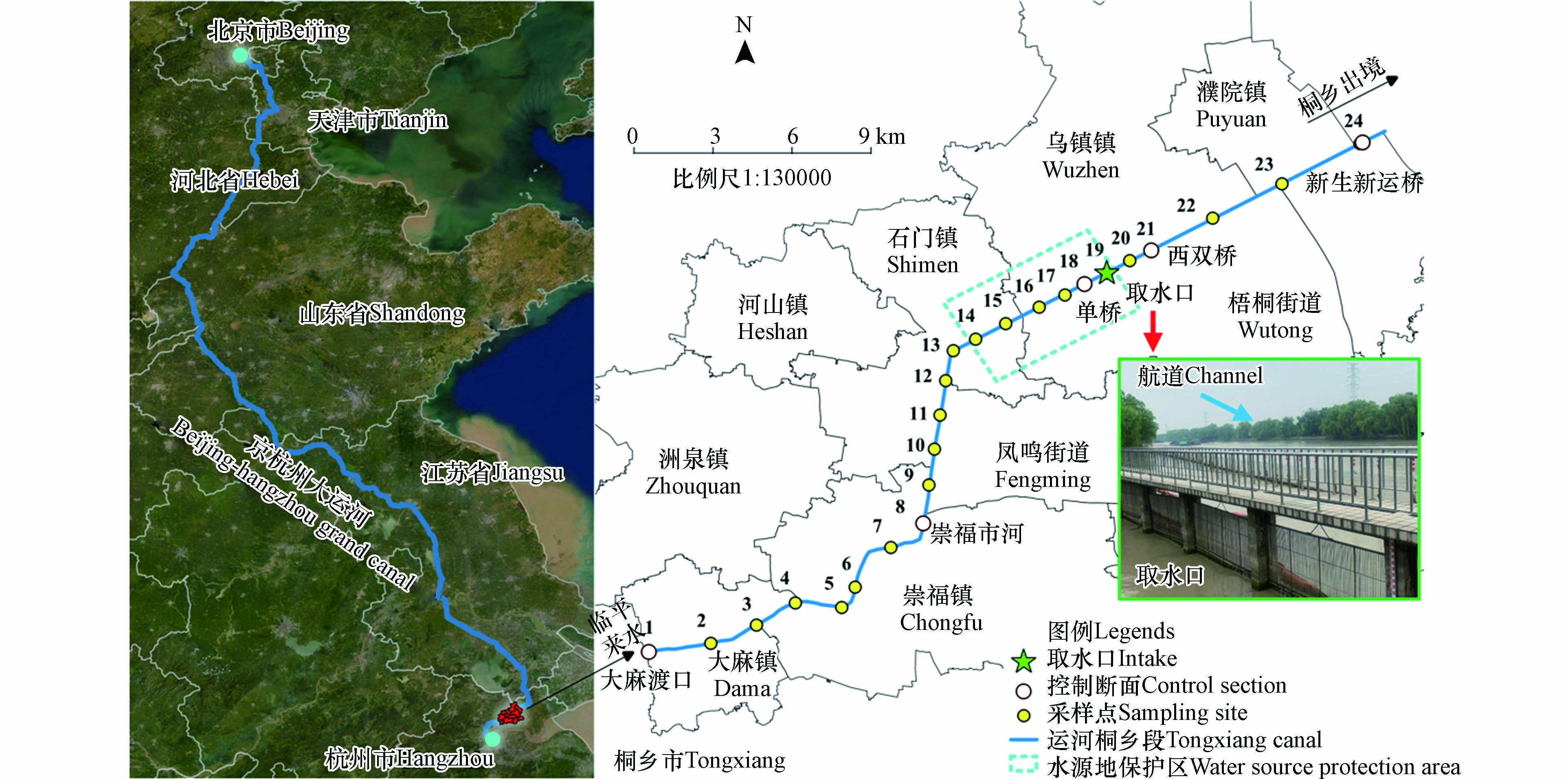
 下载:
下载:
